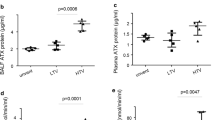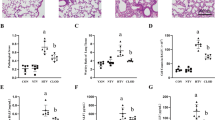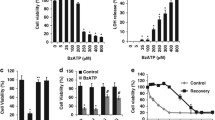Abstract
Hyperoxia is still broadly used in clinical practice in order to assure organ oxygenation in critically ill patients, albeit known toxic effects. In this present study, we hypothesize that lysophosphatidic acid (LPA) mediates NKT cell activation in a mouse model of hyperoxic lung injury. In vitro, pulmonary NKT cells were exposed to hyperoxia for 72 h, and the induction of the ectonucleotide pyrophosphatase/phosphodiesterase 2 (ENPP-2) was examined and production of lysophosphatidic acid (LPA) was measured. In vivo, animals were exposed to 100 % oxygen for 72 h and lungs and serum were harvested. Pulmonary NKT cells were then incubated with the LPA antagonist Brp-LPA. Animals received BrP-LPA prior to oxygen exposure. Autotaxin (ATX, ENPP-2) was significantly up-regulated on pulmonary NKT cells after hyperoxia (p < 0.01) in vitro. LPA levels were increased in supernatants of hyperoxia-exposed pulmonary NKT cells. LPA levels were significantly reduced by incubating NKT cells with LPA-BrP during oxygen exposure (p < 0,05) in vitro. Hyperoxia-exposed animals showed significantly increased serum levels of LPA (p ≤ 0,05) as well as increased pulmonary NKT cell numbers in vivo. BrP-LPA injection significantly improved survival as well as significantly decreased lung injury and lowered pulmonary NKT cell numbers. We conclude that NKT cell-induced hyperoxic lung injury is mediated by pro-inflammatory LPA generation, at least in part, secondary to ENPP-2 up-regulation on pulmonary NKT cells. Being a potent LPA antagonist, BrP-LPA prevents hyperoxia-induced lung injury in vitro and in vivo.





Similar content being viewed by others
References
Brennan PJ, Brigl M, Brenner MB (2013) Invariant natural killer T cells: an innate activation scheme linked to diverse effector functions. Nat Rev Immunol 13(2):101–117. doi:10.1038/nri3369
Lappas CM, Day Y-J, Marshall MA, Engelhard VH, Linden J (2006) Adenosine A2A receptor activation reduces hepatic ischemia reperfusion injury by inhibiting CD1d-dependent NKT cell activation. J Exp Med 203(12):2639–2648. doi:10.1084/jem.20061097
Bhandari V, Choo-Wing R, Lee CG et al (2006) Hyperoxia causes angiopoietin 2-mediated acute lung injury and necrotic cell death. Nat Med 12(11):1286–1293. doi:10.1038/nm1494
Baleeiro CEO, Wilcoxen SE, Morris SB, Standiford TJ, Paine R (2003) Sublethal hyperoxia impairs pulmonary innate immunity. J Immunol 171(2):955–963
Crapo JD, Barry BE, Foscue HA, Shelburne J (1980) Structural and biochemical changes in rat lungs occurring during exposures to lethal and adaptive doses of oxygen. Am Rev Respir Dis 122(1):123–143
Davis WB, Rennard SI, Bitterman PB, Crystal RG (1983) Pulmonary oxygen toxicity. Early reversible changes in human alveolar structures induced by hyperoxia. N Engl J Med 309(15):878–883. doi:10.1056/NEJM198310133091502
Nowak-Machen M, Schmelzle M, Hanidziar D et al (2013) Pulmonary natural killer T cells play an essential role in mediating hyperoxic acute lung injury. Am J Respir Cell Mol Biol 48(5):601–609. doi:10.1165/rcmb.2012-0180OC
Nakanaga K, Hama K, Aoki J (2010) Autotaxin—an LPA producing enzyme with diverse functions. J Biochem 148(1):13–24. doi:10.1093/jb/mvq052
Schleicher SM, Thotala DK, Linkous AG et al (2011) Autotaxin and LPA receptors represent potential molecular targets for the radiosensitization of murine glioma through effects on tumor vasculature. Bauer JA, ed. PLoS ONE 6(7):e22182. doi:10.1371/journal.pone.0022182
Sevastou I, Kaffe E, Mouratis M-A, Aidinis V (2013) Lysoglycerophospholipids in chronic inflammatory disorders: the PLA(2)/LPC and ATX/LPA axes. Biochim Biophys Acta 1831(1):42–60. doi:10.1016/j.bbalip.2012.07.019
Dwyer KM, Deaglio S, Gao W, Friedman D, Strom TB, Robson SC (2007) CD39 and control of cellular immune responses. Purinergic Signal 3(1-2):171–180. doi:10.1007/s11302-006-9050-y
Fox LM, Cox DG, Lockridge JL et al (2009) Recognition of lyso-phospholipids by human natural killer T lymphocytes. Cerundolo V, ed. PLoS Biol 7(10):e1000228. doi:10.1371/journal.pbio.1000228
Pellicci DG, Clarke AJ, Patel O et al (2011) Recognition of β-linked self glycolipids mediated by natural killer T cell antigen receptors. Nat Immunol 12(9):827–833. doi:10.1038/ni.2076
Rijavec M, Volarevic S, Osolnik K, Kosnik M, Korosec P (2011) Natural killer T cells in pulmonary disorders. Respir Med 105(S1):S20–S25. doi:10.1016/S0954-6111(11)70006-3
Molling JW, Moreno M, van der Vliet HJJ et al (2007) Generation and sustained expansion of mouse spleen invariant NKT cell lines with preserved cytokine releasing capacity. J Immunol Methods 322(1-2):70–81. doi:10.1016/j.jim.2007.02.002
Waxman AB, Einarsson O, Seres T et al (1998) Targeted lung expression of interleukin-11 enhances murine tolerance of 100% oxygen and diminishes hyperoxia-induced DNA fragmentation. J Clin Invest 101(9):1970–1982. doi:10.1172/JCI1337
Akbari O, Stock P, Meyer E et al (2003) Essential role of NKT cells producing IL-4 and IL-13 in the development of allergen-induced airway hyperreactivity. Nat Med 9(5):582–588. doi:10.1038/nm851
Beldi G, Banz Y, Kroemer A et al (2010) Deletion of CD39 on natural killer cells attenuates hepatic ischemia/reperfusion injury in mice. Hepatology 51(5):1702–1711. doi:10.1002/hep.23510
Schmelzle M, Eisenberger CF, am Esch JS, Matthaei H, Krausch M, Knoefel WT (2010) Non-colorectal, non-neuroendocrine, and non-sarcoma metastases of the liver: resection as a promising tool in the palliative management. Langenbeck’s Arch Surg 395(3):227–234. doi:10.1007/s00423-009-0580-y
Boutin JA, Ferry G (2009) Autotaxin. Cell Mol Life Sci 66(18):3009–3021. doi:10.1007/s00018-009-0056-9
Savaskan NE, Rocha L, Kotter MR et al (2007) Autotaxin (NPP-2) in the brain: cell type-specific expression and regulation during development and after neurotrauma. Cell Mol Life Sci 64(2):230–243. doi:10.1007/s00018-006-6412-0
Oikonomou N, Mouratis M-A, Tzouvelekis A et al (2012) Pulmonary autotaxin expression contributes to the pathogenesis of pulmonary fibrosis. Am J Respir Cell Mol Biol 47(5):566–574. doi:10.1165/rcmb.2012-0004OC
Kronenberg M, Gapin L (2002) The unconventional lifestyle of NKT cells. Nat Rev Immunol 2(8):557–568. doi:10.1038/nri854
Gapin L, Godfrey DI, Rossjohn J (2013) Natural Killer T cell obsession with self-antigens. Curr Opin Immunol 25(2):168–173. doi:10.1016/j.coi.2013.01.002
Zeissig S, Murata K, Sweet L et al (2012) Hepatitis B virus-induced lipid alterations contribute to natural killer T cell-dependent protective immunity. Nat Med 18(7):1060–1068. doi:10.1038/nm.2811
Georas SN, Berdyshev E, Hubbard W et al (2007) Lysophosphatidic acid is detectable in human bronchoalveolar lavage fluids at baseline and increased after segmental allergen challenge. Clin Exp Allergy 37(3):311–322. doi:10.1111/j.1365-2222.2006.02626.x
Holtzman MJ (2012) Asthma as a chronic disease of the innate and adaptive immune systems responding to viruses and allergens. J Clin Invest 122(8):2741–2748. doi:10.1172/JCI60325
Iwamura C, Nakayama T (2010) Role of NKT cells in allergic asthma. Curr Opin Immunol 22(6):807–813. doi:10.1016/j.coi.2010.10.008
Meyer EH, DeKruyff RH, Umetsu DT (2008) T cells and NKT cells in the pathogenesis of asthma. Annu Rev Med 59(1):281–292. doi:10.1146/annurev.med.59.061506.154139
Compliance with Ethical Standards
ᅟ
Funding
This study was partially funded grant by NIH T32 GM007592-32 (PI Keith Miller) through M Nowak-Machen.
Conflict of interest
The authors declare that they have no competing interests.
Ethical approval
All applicable international, national, and/or institutional guidelines for the care and use of animals were followed.
All procedures performed in studies involving animals were in accordance with the ethical standards of the institution or practice at which the studies were conducted.
Author contributions
MNM and SCR designed the study; AU, SW, and ML performed TLC experiments and analyzed the data; MNM performed the experiments; MNM and SCR analyzed the data and wrote the manuscript; and MAE advised on the project and edited the manuscript.
Author information
Authors and Affiliations
Corresponding author
Rights and permissions
About this article
Cite this article
Nowak-Machen, M., Lange, M., Exley, M. et al. Lysophosphatidic acid generation by pulmonary NKT cell ENPP-2/autotaxin exacerbates hyperoxic lung injury. Purinergic Signalling 11, 455–461 (2015). https://doi.org/10.1007/s11302-015-9463-6
Received:
Accepted:
Published:
Issue Date:
DOI: https://doi.org/10.1007/s11302-015-9463-6




